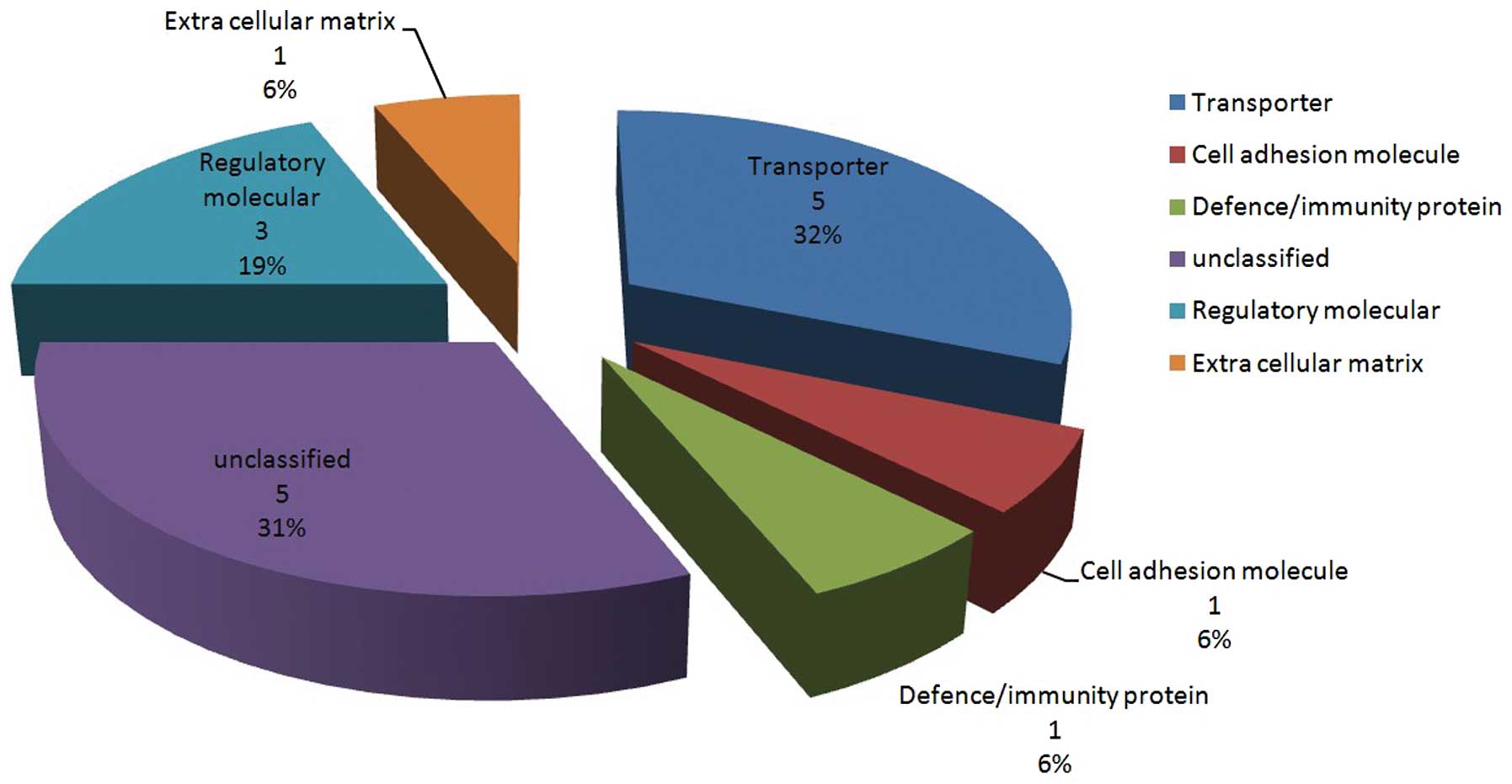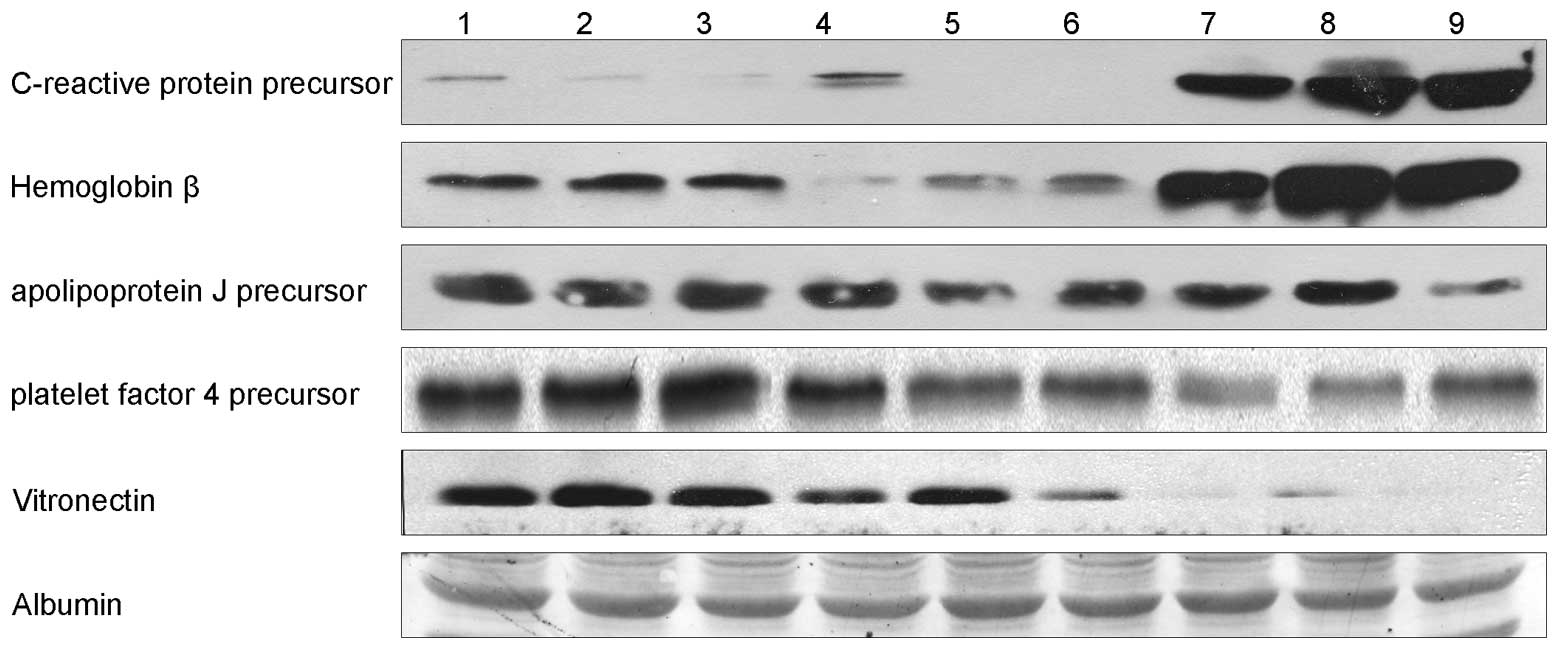|
1.
|
Chinese Society of Hepatology and Chinese
Society of Infectious Diseases, Chinese Medical Association: The
guideline of prevention and treatment for chronic hepatitis B (2010
version). Zhonghua Gan Zang Bing Za Zhi. 19:13–24. 201l.(In
Chinese).
|
|
2.
|
Lu FM and Zhuang H: Management of
hepatitis B in China. Chin Med J (Engl). 122:3–4. 2009.
|
|
3.
|
Ren F, Chen Y, Wang Y, Yan Y, Zhao J, Ding
M, Zhang J, Jiang Y, Zhai Y and Duan Z: Comparative serum proteomic
analysis of patients with acute-on-chronic liver failure:
alpha-1-acid glycoprotein maybe a candidate marker for prognosis of
hepatitis B virus infection. J Viral Hepat. 17:816–824. 2010.
View Article : Google Scholar : PubMed/NCBI
|
|
4.
|
Yang L, Rudser KD, Higgins L, Rosen HR,
Zaman A, Corless CL, David L and Gourley GR: Novel biomarker
candidates to predict hepatic fibrosis in hepatitis C identified by
serum proteomics. Dig Dis Sci. 56:3305–3315. 2011. View Article : Google Scholar : PubMed/NCBI
|
|
5.
|
Jin GZ, Li Y, Cong WM, Yu H, Dong H, Shu
H, Liu XH, Yan GQ, Zhang L, Zhang Y, et al: iTRAQ-2DLC-ESI-MS/MS
based identification of a new set of immunohistochemical biomarkers
for classification of dysplastic nodules and small hepatocellular
carcinoma. J Proteome Res. 10:3418–3428. 2011. View Article : Google Scholar : PubMed/NCBI
|
|
6.
|
Lee HJ, Na K, Choi EY, Kim KS, Kim H and
Paik YK: Simple method for quantitative analysis of N-linked
glycoproteins in hepatocellular carcinoma specimens. J Proteome
Res. 9:308–318. 2010. View Article : Google Scholar : PubMed/NCBI
|
|
7.
|
Goh WW, Lee YH, Zubaidah RM, Jin J, Dong
D, Lin Q, Chung MC and Wong L: Network-based pipeline for analyzing
MS data: an application toward liver cancer. J Proteome Res.
10:2261–2272. 2011. View Article : Google Scholar : PubMed/NCBI
|
|
8.
|
Wu WW, Wang G, Baek SJ and Shen RF:
Comparative study of three proteomic quantitative methods, DIGE,
cICAT, and iTRAQ, using 2D gel- or LC-MALDI TOF/TOF. J Proteome
Res. 5:651–658. 2006. View Article : Google Scholar : PubMed/NCBI
|
|
9.
|
Kolla V, Jenö P, Moes S, Tercanli S,
Lapaire O, Choolani M and Hahn S: Quantitative proteomics analysis
of maternal plasma in Down syndrome pregnancies using isobaric
tagging reagent (iTRAQ). J Biomed Biotechnol. 2010:9520472010.
View Article : Google Scholar : PubMed/NCBI
|
|
10.
|
Lok AS and McMahon BJ: Chronic hepatitis
B: update 2009. Hepatology. 50:661–662. 2009. View Article : Google Scholar : PubMed/NCBI
|
|
11.
|
Sarin SK, Kumar A, Almeida JA, Chawla YK,
Fan ST, Garg H, et al: Acute-on-chronic liver failure: consensus
recommendations of the Asian Pacific Association for the Study of
the Liver (APASL). Hepatol Int. 3:269–282. 2009. View Article : Google Scholar
|
|
12.
|
Nahum E, Livni G, Schiller O, Bitan S,
Ashkenazi S and Dagan O: Role of C-reactive protein velocity in the
diagnosis of early bacterial infections in children after cardiac
surgery. J Intensive Care Med. 27:191–196. 2012. View Article : Google Scholar : PubMed/NCBI
|
|
13.
|
Sklavou R, Karavanaki K, Critselis E,
Kossiva L, Giannaki M, Tsolia M, Papadakis V, Papargyri S, Vlachou
A, Karantonis F, Gourgiotis D and Polychronopoulou S: Variation of
serum C-reactive protein (CRP) over time in pediatric cancer
patients with febrile illness and its relevance to identified
pathogen. Clin Biochem. 45:1178–1182. 2012. View Article : Google Scholar : PubMed/NCBI
|
|
14.
|
Kashiwagi M, Tanaka A, Kitabata H,
Tsujioka H, Matsumoto H, Arita Y, Ookochi K, Kuroi A, Kataiwa H,
Tanimoto T, et al: Relationship between coronary arterial
remodeling, fibrous cap thickness and high-sensitivity C-reactive
protein levels in patients with acute coronary syndrome. Circ J.
73:1291–1295. 2009. View Article : Google Scholar
|
|
15.
|
Kutlar F, Redding-Lallinger R, Meiler SE,
Bakanay SM, Borders L and Kutlar A: A new sickling variant ‘Hb
S-Wake β [(Glu6Val-Asn139 Ser)]’ found in a compound heterozygote
with Hb S β (Glu6Val) coinherited with homozygous α-thalassemia-2:
phenotype and molecular characteristics. Acta Haematol.
124:120–124. 2010.
|
|
16.
|
Trougakos IP and Gonos ES:
Clusterin/apolipoprotein J in human aging and cancer. Int J Biochem
Cell Biol. 34:1430–1448. 2002. View Article : Google Scholar : PubMed/NCBI
|
|
17.
|
Gangadharan B, Bapat M, Rossa J, Antrobus
R, Chittenden D, Kampa B, Barnes E, Klenerman P, Dwek RA and
Zitzmann N: Discovery of novel biomarker candidates for liver
fibrosis in hepatitis C patients: a preliminary study. PLoS One.
7:e396032012. View Article : Google Scholar
|
|
18.
|
Poon TC, Pang RT, Chan KC, Lee NL, Chiu
RW, Tong YK, Chim SS, Ngai SM, Sung JJ and Lo YM: Proteomic
analysis reveals platelet factor 4 and beta-thromboglobulin as
prognostic markers in severe acute respiratory syndrome.
Electrophoresis. 33:1894–1900. 2012. View Article : Google Scholar : PubMed/NCBI
|
|
19.
|
Panasiuk A, Prokopowicz D, Zak J,
Matowicka-Karna J, Osada J and Wysocka J: Activation of blood
platelets in chronic hepatitis and liver cirrhosis P-selectin
expression on blood platelets and secretory activity of
beta-thromboglobulin and platelet factor-4. Hepatogastroenterology.
48:818–822. 2001.PubMed/NCBI
|
|
20.
|
Sano K, Asanuma-Date K, Arisaka F, Hattori
S and Ogawa H: Changes in glycosylation of vitronectin modulate
multimerization and collagen binding during liver regeneration.
Glycobiology. 17:784–794. 2007. View Article : Google Scholar : PubMed/NCBI
|
|
21.
|
Sano K, Miyamoto Y, Kawasaki N, Hashii N,
Itoh S, Murase M, Date K, Yokoyama M, Sato C, Kitajima K and Ogawa
H: Survival signals of hepatic stellate cells in liver regeneration
are regulated by glycosylation changes in rat vitronectin,
especially decreased sialylation. J Biol Chem. 285:17301–17309.
2010. View Article : Google Scholar
|
|
22.
|
Koukoulis GK, Shen J, Virtanen I and Gould
VE: Vitronectin in the cirrhotic liver: an immunomarker of mature
fibrosis. Hum Pathol. 32:1356–1362. 2001. View Article : Google Scholar : PubMed/NCBI
|
|
23.
|
Yamada S, Kobayashi J, Murawaki Y, Suou T
and Kawasaki H: Collagen-binding activity of plasma vitronectin in
chronic liver disease. Clin Chim Acta. 252:95–103. 1996. View Article : Google Scholar : PubMed/NCBI
|
|
24.
|
Kobayashi J, Yamada S and Kawasaki H:
Distribution of vitronectin in plasma and liver tissue:
relationship to chronic liver disease. Hepatology. 20:1412–1417.
1994. View Article : Google Scholar : PubMed/NCBI
|
|
25.
|
Tomihira M: Changes in plasma vitronectin,
fibronectin, and serum laminin P1 levels and immunohistochemical
study of vitronectin in the liver of patients with chronic liver
diseases. Fukuoka Igaku Zasshi. 82:21–30. 1991.(In Japanese).
|
















